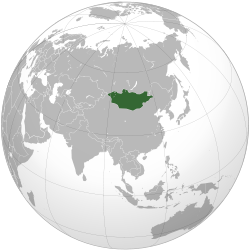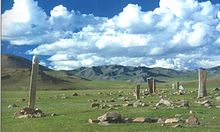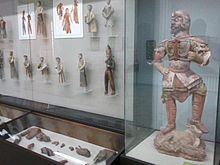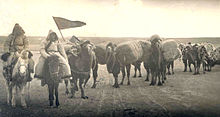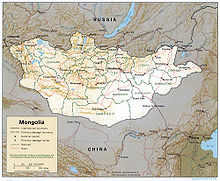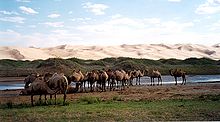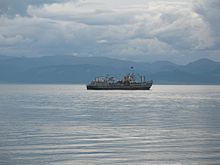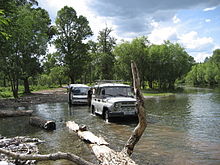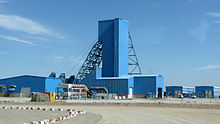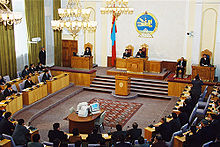
Mongolia
Did you know...
This Schools selection was originally chosen by SOS Children for schools in the developing world without internet access. It is available as a intranet download. A good way to help other children is by sponsoring a child
| Mongolia | ||||||
|---|---|---|---|---|---|---|
|
||||||
| Anthem: Монгол улсын төрийн дуулал National anthem of Mongolia |
||||||
|
|
||||||
| Capital and largest city |
Ulan Batora 47°55′N 106°53′E |
|||||
| Official script/s |
|
|||||
| Ethnic groups (2010) |
|
|||||
| Demonym |
|
|||||
| Government | Parliamentary republic | |||||
| - | President | Tsakhiagiin Elbegdorj | ||||
| - | Prime Minister | Norovyn Altankhuyag | ||||
| Legislature | State Great Khural | |||||
| Formation | ||||||
| - | Xiongnu confederation | formed 209 BC | ||||
| - | Mongol Empire | formed 1206 | ||||
| - | Independence declared (from Qing Dynasty) |
December 29, 1911 | ||||
| Area | ||||||
| - | Total | 1,564,115.75 km2 ( 19th) 603,909 sq mi |
||||
| - | Water (%) | 0.43 | ||||
| Population | ||||||
| - | 2012 census | 3,179,997 | ||||
| - | Density | 1.76/km2 ( 236th) 5.03/sq mi |
||||
| GDP ( PPP) | 2011 estimate | |||||
| - | Total | $13.264 billion | ||||
| - | Per capita | $4,743 | ||||
| GDP (nominal) | 2012 estimate | |||||
| - | Total | $9.923 billion | ||||
| - | Per capita | $3,042 | ||||
| Gini (2005) | 33.0 medium |
|||||
| HDI (2011) | medium · 100th |
|||||
| Currency | Tögrög ( MNT) |
|||||
| Time zone | ( UTC+7 to +8) | |||||
| Date format | yyyy.mm.dd ( CE) | |||||
| Drives on the | right | |||||
| Calling code | +976 | |||||
| ISO 3166 code | MN | |||||
| Internet TLD | .mn | |||||
| a. | Also spelled "Ulaanbaatar". | |||||
Mongolia / m ɒ ŋ ˈ ɡ oʊ l i ə / ( Mongolian: Монгол улс) is a landlocked country in East and Central Asia. It borders Russia to the north and China to the south, east and west. Ulan Bator, the capital and largest city, is home to about 45% of the population. Mongolia's political system is a parliamentary republic.
The area of what is now Mongolia has been ruled by various nomadic empires, including the Xiongnu, the Xianbei, the Rouran, the Gökturks and others. In 1206 Genghis Khan founded the Mongol Empire, and his grandson Kublai Khan conquered China to establish the Yuan Dynasty. After the collapse of the Yuan, the Mongols retreated to Mongolia and resumed their earlier pattern of constant internal conflict and occasional raids on the Chinese borderlands. In the 16th and 17th centuries, Mongolia came under the influence of Tibetan Buddhism. At the end of the 17th century, all of Mongolia had been incorporated into the area ruled by the Qing Dynasty. During the collapse of the Qing Dynasty in 1911, Mongolia declared independence, but had to struggle until 1921 to firmly establish de facto independence from the Republic of China, and until 1945 to gain international recognition.
The country came under strong Russian and Soviet influence; in 1924, the Mongolian People's Republic was declared, and Mongolian politics began to follow the same patterns as the Soviet politics of the time. After the breakdown of communist regimes in Eastern Europe in late 1989, Mongolia saw its own Democratic Revolution in early 1990, which led to a multi-party system, a new constitution in 1992, and transition to a market economy.
At 1,564,116 square kilometres (603,909 sq mi), Mongolia is the 19th largest and the most sparsely populated independent country in the world, with a population of around 2.75 million people. It is also the world's second-largest landlocked country after Kazakhstan. The country contains very little arable land, as much of its area is covered by steppes, with mountains to the north and west and the Gobi Desert to the south. Approximately 30% of the population are nomadic or semi-nomadic. The predominant religion in Mongolia is Tibetan Buddhism, and the majority of the state's citizens are of Mongol ethnicity, although Kazakhs, Tuvans, and other minorities also live in the country, especially in the west. About 20% of the population live on less than US$1.25 per day. Mongolia joined the World Trade Organization in 1997 and seeks to expand its participation in regional economic and trade regimes.
History
Prehistory and antiquity
Sites such as Tsagaan Agui (White Cave) in Bayankhongor Province show that Homo erectus inhabited Mongolia from 800,000 years ago. Modern humans reached Mongolia approximately 40,000 years ago during the Upper Paleolithic. The Khoid Tsenkher Cave in Khovd Province shows lively pink, brown and red ochre paintings (20,000 years ago) of mammoths, lynx, bactrian camels and ostriches, earning it the nickname "the Lascaux of Mongolia". The Mal'ta Venus (21,000 years ago) testifies to the level of Upper Paleolithic art in northern Mongolia, though Mal'ta is now part of Russia.
Neolithic agricultural settlements (c. 5500–3500 BC) such as those at Norovlin, Tamsagbulag, Bayanzag and Rashaan Khad predated the introduction of horse-riding nomadism, a pivotal event in the history of Mongolia as it became the dominant lifestyle. Horse-riding nomadism is first seen in Mongolia during the Copper and Bronze Age Afanasevo culture (3500–2500 BC) which stretched to the Khangai Mountains in Central Mongolia. The wheeled vehicles found in the burials of the Afanasevans have been dated to before 2200 BC. Pastoral nomadism and metalworking became more and more developed with the later Okunev Culture (2nd millennium BC), Andronovo culture (2300–1000 BC) and Karasuk culture (1500–300 BC), culminating with the Iron Age Xiongnu Empire in 209 BC. Monuments of the pre-Xiongnu Bronze Age include deer stones, keregsur kurgans, square slab tombs and rock paintings.
Although cultivation of crops has continued since the Neolithic it always remained small in scale compared to pastoral nomadism, which may have first been introduced from the west or arose independently in the region. The population during the Copper Age has been described as paleomongoloid in the east of what is now Mongolia, and as europoid in the west. Tocharians ( Yuezhi) and Scythians inhabited western Mongolia during the Bronze Age. The mummy of a Scythian warrior, which is believed to be about 2,500 years old, was a 30-to-40 year-old man with blond hair and was found in the Altai, Mongolia. As horse nomadism was introduced into Mongolia, the political centre of the Eurasian Steppe also shifted to Mongolia, where it remained until the 18th century CE. The intrusions of northern pastoralists (e.g. Guifang, Shanrong, Donghu) into China during the Shang dynasty (1600–1046 BC) and Zhou dynasty (1046–256 BC) presaged the age of nomadic empires.
Mongolia, since prehistoric times, has been inhabited by nomads who, from time to time, formed great confederations that rose to prominence. The first of these, the Xiongnu of undetermined ethnicity, were brought together to form a confederation by Modu Shanyu in 209 BC. Soon they emerged as the greatest threat to the Qin Dynasty, forcing the latter to construct the Great Wall of China, itself being guarded by up to almost 300,000 soldiers during marshal Meng Tian's tenure, as a means of defense against the destructive Xiongnu raids. The vast Xiongnu empire (209 BC-93 AD) was followed by the Mongolic Xianbei empire (93–234) which also ruled more than the entirety of present-day Mongolia. The Mongolic Rouran Khaganate (330–555), of Xianbei provenance, ruled a massive empire before being defeated by the Göktürks (555–745) whose empire was even bigger (laid siege to Panticapaeum, present-day Kerch, in 576). They were succeeded by the Uyghur Khaganate (745–840) who were defeated by the Kyrgyz. The Mongolic Khitans, descendants of the Xianbei, ruled Mongolia during the Liao Dynasty (907–1125), after which the Khamag Mongol (1125–1206) rose to prominence.
Middle Ages to independence
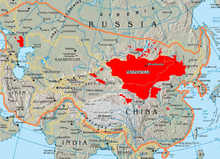
In the chaos of the late 12th century, a chieftain named Temüjin finally succeeded in uniting the Mongol tribes (belonging to the Shiwei branch of the Mongolic Xianbei) between Manchuria and the Altai Mountains. In 1206, he took the title Genghis Khan, and waged a series of military campaigns – renowned for their brutality and ferocity – sweeping through much of Asia, and forming the Mongol Empire, the largest contiguous land empire in world history. Under his successors it stretched from present-day Poland in the west to Korea in the east, and from Siberia in the north to the Gulf of Oman and Vietnam in the south, covering some 33,000,000 square kilometres (13,000,000 sq mi), (22% of Earth's total land area) and having a population of over 100 million people. The emergence of Pax Mongolica also significantly eased trade and commerce across Asia during its height.
After Genghis Khan's death, the empire was subdivided into four kingdoms or Khanates which eventually became quasi-independent after Möngke's death in 1259. One of the khanates, the "Great Khaanate", consisting of the Mongol homeland and China, became the Yuan Dynasty under Kublai Khan, the grandson of Genghis Khan. He set up his capital in present day Beijing but after more than a century of power, the Yuan was replaced by the Ming Dynasty in 1368, with the Mongol court fleeing to the north. As the Ming armies pursued the Mongols into their homeland, they successfully sacked and destroyed the Mongol capital Karakorum among a few other cities, although some of these attempts were repelled by the Mongols under Ayushridar and his general Köke Temür.
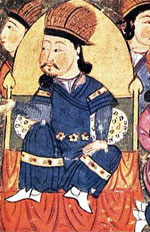
After the expulsion of the Yuan Dynasty rulers from China, the Mongols continued to rule Mongolia, also referred to as the Northern Yuan. The next centuries were marked by violent power struggles among various factions, notably the Genghisids and the non-Genghisid Oirads, as well as by several Chinese invasions (like the five expeditions led by the Yongle Emperor). In the early 15th century, the Oirads under Esen Tayisi gained the upper hand, and even raided China in 1449 in a conflict over Esen's right to pay tribute, capturing the Ming emperor in the process. However, Esen was murdered in 1454, and the Borjigids recovered.
Batumöngke Dayan Khan and his khatun Mandukhai reunited the entire Mongol nation under the Genghisids in the early 16th century. In the mid-16th century, Altan Khan of the Tümed, a grandson of Dayan Khan – but no legitimate Khan himself – became powerful. He founded Hohhot in 1557 and his meeting with the Dalai Lama in 1578 sparked the second introduction of Tibetan Buddhism to Mongolia. Abtai Khan of the Khalkha converted to Buddhism and founded the Erdene Zuu monastery in 1585. His grandson Zanabazar became the first Jebtsundamba Khutughtu in 1640. The entire Mongolian population embraced Buddhism. Each family kept scriptures and Buddha statues on an altar at the north side of their ger (yurt). Mongolian nobles donated land, money and herders to the monasteries. The top monasteries wielded significant temporal power besides spiritual power.
The last Mongol Khan was Ligden Khan in the early 17th century. He got into conflicts with the Manchus over the looting of Chinese cities, and managed to alienate most Mongol tribes. He died in 1634 on his way to Tibet, in an attempt to evade the Manchus and destroy the Yellow Hat sect of Buddhism. By 1636, most Inner Mongolian tribes had submitted to the Manchus, who founded the Qing Dynasty. The Khalkha eventually submitted to Qing rule in 1691, thus bringing all of today's Mongolia under Beijing's rule. After several wars, the Dzungars (the western Mongols or Oirats) were virtually annihilated during the Qing conquest of Dzungaria in 1757–58.
Some scholars estimate that about 80% of the 600,000 or more Dzungars were destroyed by a combination of disease and warfare. Outer Mongolia was given relative autonomy, being administered by the hereditary Genghisid khanates of Tusheet Khan, Setsen Khan, Zasagt Khan and Sain Noyon Khan. The Jebtsundamba Khutuktu of Mongolia had immense de facto authority. The Manchus also forbade mass Chinese immigration, allowing the Mongols to keep their culture. The main trade route during this period was the Tea Road which had permanent stations located every 25–30 km each of which was staffed by 5-30 chosen families. Urga (present-day Ulaanbaatar) benefited greatly from this overland trade as it was the only major settlement in Outer Mongolia used as a stopover point by merchants, officials and travelers on the Tea Road.
Until 1911, the Qing Dynasty maintained control of Mongolia with a series of alliances and intermarriages, as well as military and economic measures. Ambans, Manchu "high officials", were installed in Khüree, Uliastai, and Khovd, and the country was subdivided into ever more feudal and ecclesiastical fiefdoms. Over the course of the 19th century, the feudal lords attached more importance to representation and less importance to the responsibilities towards their subjects. The behaviour of Mongolia's nobility, together with the usurious practices of the Chinese traders and the collection of imperial taxes in silver instead of animals, resulted in poverty becoming ever more rampant. By 1911 there were 700 large and small monasteries in Outer Mongolia and 115,000 monks who made up 21% of the population. Apart from the Jebtsundamba Khutuktu there were 13 other reincarnating high-lamas called 'seal-holding saints' (tamgatai khutuktu) in Outer Mongolia.
Post-independence
With the fall of the Qing Dynasty, Mongolia under the Bogd Khaan declared independence in 1911. However, the newly established Republic of China considered Mongolia to be part of its own territory. The area controlled by the Bogd Khaan was approximately that of the former Outer Mongolia during the Qing period. In 1919, after the October Revolution in Russia, Chinese troops led by Xu Shuzheng occupied Mongolia.
However, as a result of the Russian Civil War, the White Russian adventurer Baron Ungern led his troops into Mongolia in October 1920, defeating the Chinese forces in Niislel Khüree (Ulaanbaatar) in early February 1921. In order to eliminate the threat posed by Ungern, Bolshevik Russia decided to support the establishment of a communist Mongolian government and army. This Mongolian army took the Mongolian part of Kyakhta from Chinese forces on March 18, 1921, and on July 6 Russian and Mongolian troops arrived in Khüree. Mongolia's independence was declared once again on July 11, 1921. These events led to Mongolia's close alignment with the Soviet Union over the next seven decades.
In 1924, after the death of the religious leader and khan, Bogd Khan, a Mongolian People's Republic was proclaimed with support from the Soviet Union.
In 1928, Khorloogiin Choibalsan rose to power. He instituted collectivisation of livestock, the destruction of Buddhist monasteries and the Stalinist repressions in Mongolia resulting in the murder of monks and other people. In Mongolia during the 1920s, approximately one-third of the male population were monks. By the beginning of the 20th century, about 750 monasteries were functioning in Mongolia. The Stalinist purges in Mongolia that began in 1937 affected the Republic by killing more than 30,000 people. Japanese imperialism became even more alarming after the invasion of neighboring Manchuria in 1931. During the Soviet-Japanese Border War of 1939, the Soviet Union successfully defended Mongolia against Japanese expansionism.
In August 1945 Mongolian forces also took part in the Soviet Manchurian Strategic Offensive Operation in Inner Mongolia. The Soviet threat of seizing parts of Inner Mongolia induced China to recognize Outer Mongolia's independence, provided that a referendum be held. The referendum took place on October 20, 1945, with (according to official numbers) 100% of the electorate voting for independence. After the establishment of the People's Republic of China, both countries confirmed their mutual recognition on October 6, 1949. On January 26, 1952, Yumjaagiin Tsedenbal took power. In 1956 and again in 1962, Choibalsan's personality cult was condemned at the ruling Mongolian People's Revolutionary Party Central Committee plenums. Mongolia continued to align itself closely with the Soviet Union, especially after the Sino-Soviet split of the late 1950s. In the 1980s, an estimated 55,000 Soviet troops were based in Mongolia. While Tsedenbal was visiting Moscow in August 1984, his severe illness prompted the parliament to announce his retirement and replace him with Jambyn Batmönkh.
The introduction of perestroika and glasnost in the USSR by Mikhail Gorbachev strongly influenced Mongolian politics, leading to the peaceful Democratic Revolution and the introduction of a multi-party system and market economy. A new constitution was introduced in 1992, and the "People's Republic" was dropped from the country's name. The transition to market economy was often rocky. The early 1990s saw high inflation and food shortages. The first election wins for non-communist parties came in 1993 (presidential elections) and 1996 (parliamentary elections). The signing of the Oyu Tolgoi mine contract is considered a major milestone in modern Mongolian history. The Mongolian People's Revolutionary Party renamed itself the Mongolian People's Party in 2010.
Geography and climate
At 1,564,116 km2 (603,909 sq mi), Mongolia is the world's 19th-largest country (after Iran). It is significantly larger than the next-largest country, Peru. It mostly lies between latitudes 41° and 52°N (a small area is north of 52°), and longitudes 87° and 120°E. Although Mongolia does not share a border with Kazakhstan, its westernmost point is only 38 kilometres (24 mi) from Kazakhstan.
The geography of Mongolia is varied, with the Gobi Desert to the south and with cold and mountainous regions to the north and west. Much of Mongolia consists of steppes. The highest point in Mongolia is the Khüiten Peak in the Tavan bogd massif in the far west at 4,374 m (14,350 ft). The basin of the Uvs Lake, shared with Tuva Republic in Russia, is a natural World Heritage Site. Most of the country is hot in the summer and extremely cold in the winter, with January averages dropping as low as −30 °C (−22 °F). A vast front of cold, heavy, shallow air comes in from Siberia in winter and collects in river valleys and low basins causing very cold temperatures while slopes of mountains are much warmer due to the effects of temperature inversion (temperature increases with altitude).
In winter the whole of Mongolia comes under the influence of the Siberian Anticyclone. The localities most severely affected by this cold weather are Uvs province ( Ulaangom), western Khovsgol ( Rinchinlhumbe), eastern Zavkhan ( Tosontsengel), northern Bulgan (Hutag) and eastern Dornod province (Khalkhiin Gol). Ulaanbaatar is also strongly affected but not as severely. The cold gets less severe as one goes south, reaching the warmest January temperatures in Omnogovi Province ( Dalanzadgad, Khanbogd) and the region of the Altai mountains bordering China. A unique microclimate is the fertile grassland-forest region of central and eastern Arkhangai Province ( Tsetserleg) and northern Ovorkhangai Province ( Arvaikheer) where January temperatures are on average the same and often higher than the warmest desert regions to the south in addition to being more stable. The Khangai Mountains play a certain role in forming this microclimate. In Tsetserleg, the warmest town in this microclimate, nighttime January temperatures rarely go under -30°C while daytime January temperatures often reach 0°C to 5°C and locals rarely have the stinging sensations associated with early frostbite. In Mongolia, being exposed to temperatures ranging from -30°C to -40°C for more than 60 minutes may increase the risk of frostbite. A strong wind at those temperatures almost certainly leads to frostbite even for Mongolians (who have special physical adaptations to the cold).
The country is subject to occasional harsh climatic conditions known as zud. The annual average temperature in Ulan Bator is 0°C, making it the world's coldest capital city. Mongolia is high, cold, and windy. It has an extreme continental climate with long, cold winters and short summers, during which most of its annual precipitation falls. The country averages 257 cloudless days a year, and it is usually at the centre of a region of high atmospheric pressure. Precipitation is highest in the north (average of 200 to 350 millimeters (7.9 to 13.8 in) per year) and lowest in the south, which receives 100 to 200 millimeters (3.9 to 7.9 in) annually. The highest annual precipitation of 622.297mm occurred in the forests of Bulgan Province close to the border with Russia and the lowest of 41.735mm occurred in the Gobi Desert (period 1961-1990). The sparsely populated far north of Bulgan Province averages 600mm in annual precipitation which means it receives more precipitation than Beijing (571.8mm) or Berlin (571mm).
The name "Gobi" is a Mongol term for a desert steppe, which usually refers to a category of arid rangeland with insufficient vegetation to support marmots but with enough to support camels. Mongols distinguish Gobi from desert proper, although the distinction is not always apparent to outsiders unfamiliar with the Mongolian landscape. Gobi rangelands are fragile and are easily destroyed by overgrazing, which results in expansion of the true desert, a stony waste where not even Bactrian camels can survive.
Administrative divisions
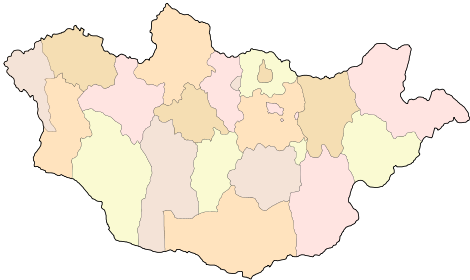 Zavkhan
Govi-Altai
Khovd
Bayan-
Ölgii Uvs
Bayan.
Övör.
Ömnögovi
Dundgovi
Dornogovi
Arkhangai
Khövsgöl
Töv
Khentii
Sükhbaatar
Dornod
Selenge
Darkh.
Bulgan
Orkhon
Ulan Bator
Govisum.
|
Mongolia is divided into 21 aimags ( provinces), which are in turn divided into 329 sums ( districts). The capital Ulaanbaatar is administrated separately as a capital city ( municipality) with provincial status. The aimags are:
|
|
|
Major cities
About 40% of the population lives in Ulaanbaatar, and in 2002 a further 23% lived in Darkhan, Erdenet, the aimag centers and sum-level permanent settlements. Another share of the population lives in the sum centers.
Economy
Economic activity in Mongolia has traditionally been based on herding and agriculture, although development of extensive mineral deposits of copper, coal, molybdenum, tin, tungsten, and gold have emerged as a driver of industrial production. Besides mining (21.8% of GDP) and agriculture (16% of GDP), dominant industries in the composition of GDP are wholesale and retail trade and service, transportation and storage, and real estate activities. The grey economy is estimated to be at least one-third the size of the official economy. As of 2006, 68.4% of Mongolia's exports went to the PRC, and the PRC supplied 29.8% of Mongolia's imports.
Mongolia is ranked as lower middle income economy by the World Bank. 22.4% of the population lives on less than US $1.25 a day. GDP per capita in 2011 was $3,100. Despite growth, the proportion of the population below the poverty line was estimated to be 35.6% in 1998, 36.1% in 2002–2003, 32.2% in 2006.
Because of a boom in the mining sector, Mongolia had high growth rates in 2007 and 2008 (9.9% and 8.9%, respectively). In 2009, sharp drops in commodity prices and the effects of the global financial crisis caused the local currency to drop 40% against the U.S. dollar. Two of the 16 commercial banks were taken into receivership. GDP growth in 2011 was expected to reach 16.4%. However, inflation continued to erode GDP gains, with an average rate of 12.6% expected in Mongolia at the end of 2011. Although GDP has risen steadily since 2002 at the rate of 7.5% in an official 2006 estimate, the state is still working to overcome a sizable trade deficit. The Economist expects this trade deficit of 14% of Mongolia's GDP to transform into a surplus in 2013.
Mongolia was never listed among the Emerging markets countries until February 2011 when Citigroup analysts determined Mongolia to be one of Global Growth Generators countries which being countries with the most promising growth prospects for 2010–2050. The Mongolian Stock Exchange, established in 1991 in Ulan Bator, is among the world's smallest stock exchanges by market capitalisation. In 2011, it had 336 companies listed with a total market capitalization of US$2 billion after quadrupling from US$406 million in 2008. Mongolia made a significant improvement on the ease of doing business in 2012, moving up to rank 76 compared with 88 last year in the “Doing Business” report by the International Finance Corporation (IFC).
Mineral industry
Minerals represent more than 80% of Mongolia's exports, a proportion expected to eventually rise to 95%. About 3,000 mining licences have been issued. Mining is continuing to rise as a major industry of Mongolia as evidenced by number of Chinese, Russian and Canadian firms opening and starting mining business in Mongolia.
In summer 2009 the government negotiated an “Investment Agreement” with Rio Tinto and Ivanhoe Mines to develop the Oyu Tolgoi copper and gold deposit, the biggest foreign-investment project in Mongolia, expected to account for one-third of Mongolia’s GDP by 2020. In March 2011, six big mining companies prepared to bid for the Tavan Tolgoi area, the world's largest untapped coal deposit. According to Erdenes MGL, the government body in-charge of Tavan Tolgoi, ArcelorMittal, Vale, Xstrata, U.S. coal miner Peabody, a consortium of Chinese energy firm Shenhua and Japan's Mitsui & Co, and a separate consortium of Japanese, South Korean and Russian firms are the preferred bidders.
Infrastructure
Science and Technology
Energy
Transportation
The Trans-Mongolian Railway is the main rail link between Mongolia and its neighbors. It begins at the Trans-Siberian Railway in Russia at the town of Ulan-Ude, crosses into Mongolia, runs through Ulaanbaatar, then passes into China at Erenhot where it joins the Chinese railway system. A separate railroad link connects the eastern city of Choibalsan with the Trans-Siberian Railway. However, that link is closed to passengers after the Mongolian town of Chuluunkhoroot.
Mongolia has a number of domestic airports with some of them having international status. However, the main international airport is Chinggis Khaan International Airport, located approximately 20 km from centre of Ulaanbaatar. Direct flight connections exist between Mongolia and South Korea, China, Japan, Russia, Germany, Kyrgyzstan, and Turkey. MIAT Mongolian Airlines is Mongolia's national air carrier operating only international flights, while other domestic air carriers such as Eznis Airways, AeroMongolia and Mongolian Airlines Group are serving both domestic and regional routes.
Many overland roads in Mongolia are only gravel roads or simple cross-country tracks. There are paved roads from Ulaanbaatar to the Russian and Chinese border, from Ulaanbaatar east- and westward (the so-called Millenium Road), and from Darkhan to Bulgan. A number of road construction projects are currently underway.
Education
During the state socialist period, education was one of the areas of significant achievement in Mongolia. Illiteracy was virtually eliminated, in part through the use of seasonal boarding schools for children of nomadic families. Funding to these boarding schools was cut in the 1990s, contributing to slightly increased illiteracy.
Primary and secondary education formerly lasted 10 years, but was expanded to 11 years. Since the 2008–2009 school year, new first graders are using the 12 year system. As such, full transition to the 12-year system will not happen until the 2019–2020 school year, when the current third graders graduate.
As of 2006, across Mongolia, English is taught in all secondary schools beginning in fourth grade.
Mongolian national universities are all spin-offs from the National University of Mongolia and the Mongolian University of Science and Technology.
Health
Since 1990, key health indicators like life expectancy and infant and child mortality have steadily improved, both due to social changes and to improvement in the health sector. However, serious problems remain, especially in the countryside. According to a 2011 study by the World Health Organization, Mongolia's capital city of Ulan Bator has the second-most fine particle pollution of any city in the world. Open urination and defecation is still practiced in the streets of Mongolia; according to a joint WHO and UNICEF inspection in 2010, the proportion of the Mongolian population without access to personal or shared sanitation facilities and who engaged in open defecation was 26% in rural areas, 3% in urban areas, and 12% overall.
Average childbirth ( fertility rate) is around 2.25 – 1.87 per woman (2007) and average life expectancy is 68.5 years (2011). Infant mortality is at 1.9%-4% and child mortality is at 4.3%.
The health sector comprises 17 specialized hospitals and centers, 4 regional diagnostic and treatment centers, 9 district and 21 aimag general hospitals, 323 soum hospitals, 18 feldsher posts, 233 family group practices, and 536 private hospitals and 57 drug supply companies/pharmacies. In 2002 the total number of health workers was 33,273, of which 6823 were doctors, 788 pharmacists, 7802 nurses, and 14,091 mid-level personnel. At present, there are 27.7 physicians and 75.7 hospital beds per 10,000 inhabitants.
Politics
Mongolia is a parliamentary republic. The president is directly elected. The people also elect the deputies in the national assembly, the State Great Khural, which chooses the prime minister, who nominates the Cabinet in consultation with the president. The Khural confirms the ministers. Mongolia's constitution guarantees a number of freedoms, including full freedom of expression and religion. Mongolia has a number of political parties, the biggest are the Mongolian People's Party and the Democratic Party.
The People's Party - the People's Revolutionary Party between 1921 and 2010 - formed the government of the country from 1921 to 1996 (in a one-party system until 1990) and from 2000 to 2004. From 2004 to 2006, it was part of a coalition with the Democrats and two other parties, and after 2006 it was the dominant party in two other coalitions. The party initiated two changes of government from 2004 until it lost power in a 2012 election. The Democrats were the dominant force in a ruling coalition between 1996 and 2000, and an almost-equal partner with the People's Revolutionary Party in a coalition between 2004 and 2006. An election of deputies to the national assembly on 28 June 2012 resulted in no party having an overall majority. The Democratic Party won most seats and its leader, Norovyn Altankhuyag, became prime minister on 10 August 2012.
The President of Mongolia has a largely symbolic role, but can block the Parliament's decisions. The assembly can respond by overruling that veto by a two-thirds majority vote. Mongolia's constitution provides three requirements for taking office as president; the candidate must be a native-born Mongolian, be at least 45 years old, and have resided in Mongolia for five years before taking office. The president must also formally resign his or her party membership. Tsakhiagiin Elbegdorj, a two-time former prime minister and ex-member of the Democratic Party was elected as president on May 24, 2009 and inaugurated on June 18 that year.
Mongolia uses a unicameral parliamentary system in which the president has a symbolic role and the government chosen by the legislature exercises executive power. The legislative arm, the State Great Khural, has one chamber with 76 seats and is chaired by the speaker of the house. It elects its members every four years by general elections. The State Great Khural is powerful in the Mongolian government with the president being largely symbolic and the prime minister being chosen by the parliament from among its own membership.
Foreign relations
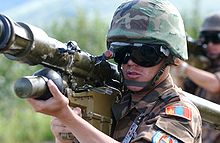
Mongolia maintains positive relations and has diplomatic missions in many countries such as Russia, the People's Republic of China, India, North and South Korea, Japan, and the United States. The government has focused a great deal on encouraging foreign investments and trade.
Mongolia has embassies in Almaty, Ankara, Bangkok, Berlin, Beijing, Brussels, Budapest, Cairo, Canberra, Warsaw, Washington, D.C., Vienna, Vientiane, Havana, New Delhi, Kuwait City, London, Moscow, Ottawa, Paris, Prague, Pyongyang, Seoul, Sofia, Stockholm, Tokyo, Hanoi, and Singapore, a consulate in Irkutsk and Ulan-Ude, and diplomatic missions to the United Nations in New York City and in Geneva.
Foreign relations and military
Mongolia supported the 2003 invasion of Iraq, and has sent several successive contingents of 103 to 180 troops each to Iraq. About 130 troops are currently deployed in Afghanistan. 200 Mongolian troops are serving in Sierra Leone on a UN mandate to protect the UN's special court set up there, and in July 2009, Mongolia decided to send a battalion to Chad in support of MINURCAT.
From 2005 to 2006, about 40 troops were deployed with the Belgian and Luxembourgish contingent in Kosovo. On November 21, 2005, George W. Bush became the first-ever sitting U.S. President to visit Mongolia. In 2004, under the Bulgarian chairmanship, The Organisation for Security and Cooperation in Europe (OSCE), invited Mongolia as its newest Asian Partner. In August, 2011, U.S. vice president Joe Biden made the first visit by a sitting vice president to Mongolia since Henry Wallace toured the region in 1944.



